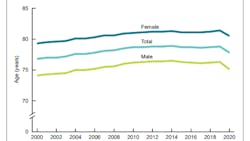CDC report highlights life expectancy drop in the US during 2020
A consequence of COVID-19 is a sudden drop in life expectancy in the United States, according to a National Vital Statistics System (NVSS) Vital Statistics Rapid Release report released by the Centers for Disease Control and Prevention (CDC).
Life expectancy dropped one full year during the first half of 2020, declining from 78.8 years in 2019 to 77.8 years for January through June 2020.
Life expectancy at birth for males was 75.1 years in the first half of 2020, representing a decline of 1.2 years from 76.3 years in 2019. For females, life expectancy declined to 80.5 years, decreasing 0.9 year from 81.4 years in 2019. The difference in life expectancy between the sexes was 5.4 years in the first half of 2020, increasing from 5.1 in 2019. Between 2000 and 2010, the difference in life expectancy between the sexes narrowed from 5.2 years to its lowest level of 4.8 years and then gradually increasing to 5.1 years in 2019.
The new projection is the lowest it’s been since 2006 — and it had been on the rise in both 2018 and 2019. The National Center for Health Statistics (NCHS) collects and disseminates the nation’s official vital statistics through the NVSS. NCHS uses provisional vital statistics data for conducting public health surveillance and final data for producing annual national natality and mortality statistics. In order to assess the effects on life expectancy of excess mortality observed during 2020, NCHS is publishing, for the first time, life tables based on provisional vital statistics data.
Another consequence of the decreased life expectancy estimates observed during the first half of 2020 was a worsening of racial and ethnic mortality disparities. For example, the gap in life expectancy at birth between the non-Hispanic black and white populations increased by 46 percent between 2019 and the first half of 2020 (from 4.1 to 6.0 years). Regardless of Hispanic origin, life expectancy for the black population has consistently been lower than that of the white population but the gap between the two races had generally been narrowing since 1993 when it was 7.1 years.
The gap of 6.0 years observed in the first half of 2020 is the largest since 1998. Conversely, the gap between the Hispanic and non-Hispanic white populations decreased by 37 percent between 2019 and the first half of 2020 (from 3.0 to 1.9 years). This indicates that the Hispanic population lost some of the mortality advantage it has evidenced since 2006 relative to the non-Hispanic white population, despite experiencing generally lower socioeconomic status.
First, they are based on deaths that occurred during the first 6 months of the year and do not reflect the entirety of the effects of the COVID-19 pandemic in 2020, or other changes in causes of death, such as the increases in provisional drug overdose deaths through early 2020. There is seasonality in death patterns in any given year, with winter months typically seeing more deaths than summer months, and this is not accounted for in the data.
Second, the COVID-19 pandemic differentially affected certain geographic areas in the first half of 2020. The life table estimates may disproportionately represent mortality in those regions, which are more urban and have different demographic characteristics than areas affected by the pandemic in the latter part of the year. As a result, life expectancy at birth for the first half of 2020 may be underestimated since the populations more severely affected, Hispanic and non-Hispanic black populations, are more likely to live in urban areas.
The provisional mortality data on which the life tables are based also have a number of limitations. First, the timeliness of death certificate data varies by jurisdiction. More recently, jurisdictions were differently affected by the pandemic. Many jurisdictions increased their frequency of death certificate submissions, while some faced staffing challenges, data processing disruptions, or other issues. Some jurisdictions expanded their use of electronic death registration systems in 2020, which may have affected the timeliness of data submission. The effect of recent changes in timeliness will not be apparent until data are finalized.
